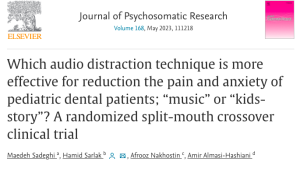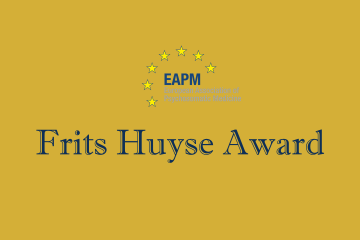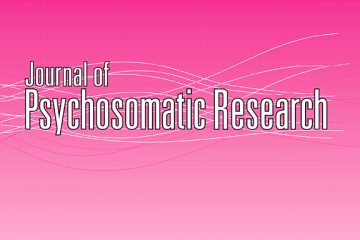The Editor’s choice May 2023
written by Antonina Mikocka-Walus, Deputy Editor, Journal of Psychosomatic Research and Jess G. Fiedorowicz, Editor-in-Chief, Journal of Psychosomatic Research, Professor and Senior Research Chair in Adult Psychiatry, University of Ottawa, Head and Chief of Mental Health, The Ottawa Hospital Scientist, Ottawa Hospital Research Institute, in May 2023.

Antonina Mikocka-Walus, Deputy Editor
The Editor’s Choice –
“No difference in effectiveness of audio-story and music as distraction techniques during dental procedures in a paediatric population“
A recent systematic review reports that nearly 25% of children (3-18 years old) experience dental anxiety (DA), with the prevalence as high as 36.5% in preschoolers.1 If poorly managed, dental anxiety continues into adulthood (11.6% of adults report high levels of DA)2 with dire consequences for overall health such as increased risk of cardiovascular disease and diabetes.3 This quarter’s Editor’s Choice article4 explores the role of distraction techniques (i.e., audio story versus music) in reducing pain and anxiety during paediatric dental procedures.
A systematic review of 18 randomised controlled trials on the effects of music during dental procedures in adults and children demonstrates efficacy in reducing anxiety and pain, lowering heart rate, and normalising blood pressure.5 However, less is known about other audio distraction techniques in children. The novelty of the present trial lies in comparing audio story to music in its effect on pain and anxiety during paediatric dental procedures.
This split-mouth clinical trial randomized healthy 4–8-year-old dental patients requiring an anaesthetic and a dental procedure (i.e., pulpotomy and stainless-steel crown of first or second molars) into two groups (n = 30 each) according to the order of the audio distraction techniques received in the first and second treatment sessions. All trial patients received both distraction techniques for dental treatment. Split-mouth trials are commonly used in oral health but may be less known to health researchers working in other areas of health science. The split-mouth trials typically randomly assign participants to the right or left half of the dentition in order to remove inter-individual variability from the estimates of the treatment effect.6 Participant groups in these trials usually undertake two or more interventions. Like the more familiar cross-over studies, there is risk of contamination of effects between one intervention and another.7 The present study applied a crossover design where one group listened to an audio story in the first treatment session and music in the second treatment session, while the second group received these two interventions in the reverse order. The two treatment sessions were scheduled with two weeks. Parents and assessors were blinded to the group allocation; however, the children and dental therapists could not be. The outcome measures included pulse rate (physiological outcome), the SEM pain scale (objective outcome) and the Wong-baker faces pain rating (subjective outcome).
The study showed no significant group difference on any of the outcome measures between the two distraction techniques. Importantly, given the limitations of split-mouth designs, the analysis explored the carryover effect and did not find any evidence of carryover effects on the outcome measures. This means that any treatment effects were not transferred from the first to the second period. No safety concerns were recorded.
The study provides reassurance that non-pharmacological interventions can be a feasible and safe option during painful dental procedures in children. Importantly, the trial involved some significant design improvements in comparison to other similar studies, for example, the crossover design and the analysis which explored the carryover effect.
References
- Grisolia BM, Dos Santos APP, Dhyppolito IM, Buchanan H, Hill K, Oliveira BH. Prevalence of dental anxiety in children and adolescents globally: A systematic review with meta-analyses. International journal of paediatric dentistry. 2021;31(2):168-83.
- Humphris G, Crawford JR, Hill K, Gilbert A, Freeman R. UK population norms for the modified dental anxiety scale with percentile calculator: adult dental health survey 2009 results. BMC oral health. 2013;13:29.
- Guo D, Shi Z, Luo Y, Ding R, He P. Association between oral health behavior and chronic diseases among middle-aged and older adults in Beijing, China. BMC oral health. 2023;23(1):97.
- Sadeghi M, Sarlak H, Nakhostin A, Almasi-Hashiani A. Which audio distraction technique is more effective for reduction the pain and anxiety of pediatric dental patients; “music” or “kids-story”? A randomized split-mouth crossover clinical trial. Journal of psychosomatic research. 2023;168:111218.
- Tan K, Liu H, Huang S, Li C. Efficacy of Music Intervention for Dental Anxiety Disorders: A Systematic Review and Meta-Analysis. Medicina (Kaunas, Lithuania). 2023;59(2).
- Lesaffre E, Philstrom B, Needleman I, Worthington H. The design and analysis of split-mouth studies: what statisticians and clinicians should know. Statistics in medicine. 2009;28(28):3470-82.
- Pandis N, Walsh T, Polychronopoulou A, Katsaros C, Eliades T. Split-mouth designs in orthodontics: an overview with applications to orthodontic clinical trials. European journal of orthodontics. 2013;35(6):783-9.





0 Comments